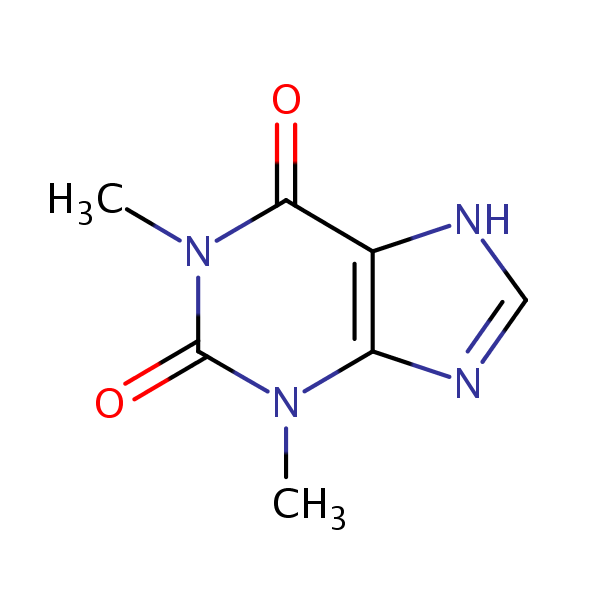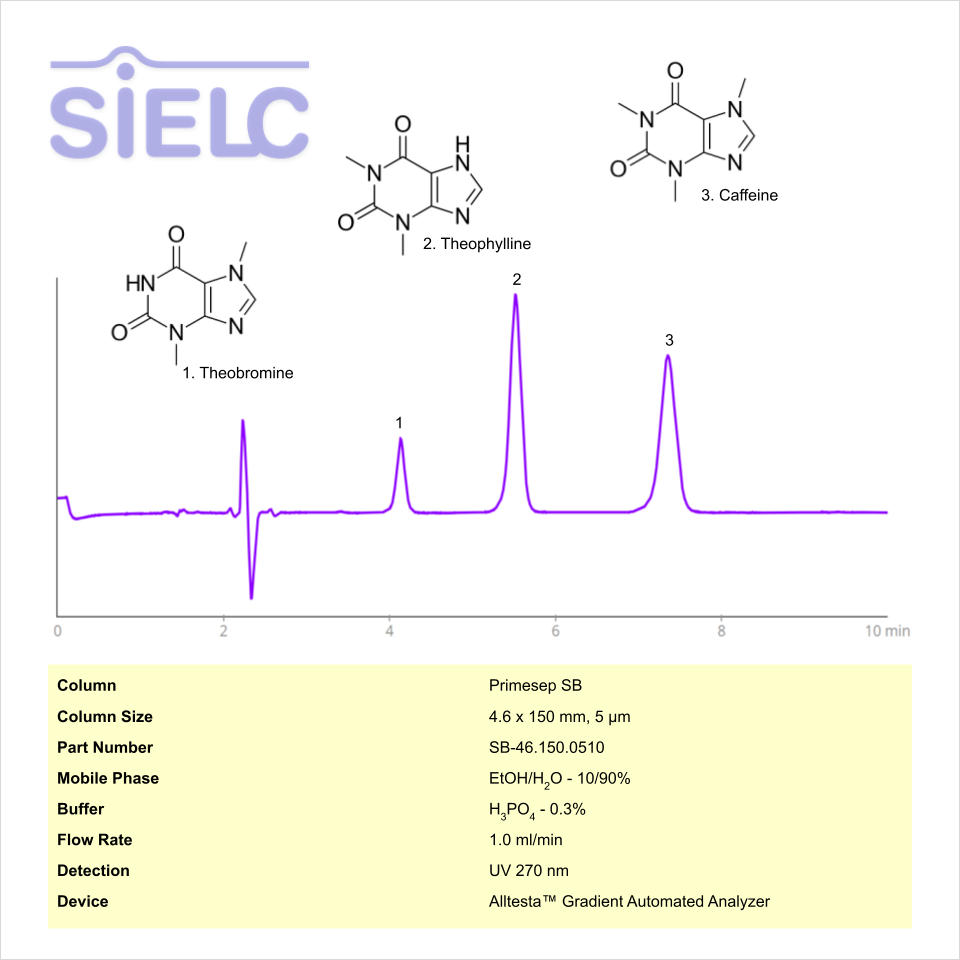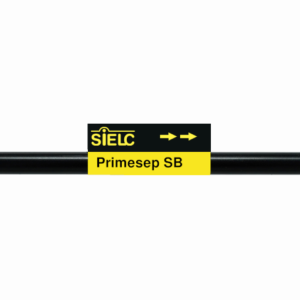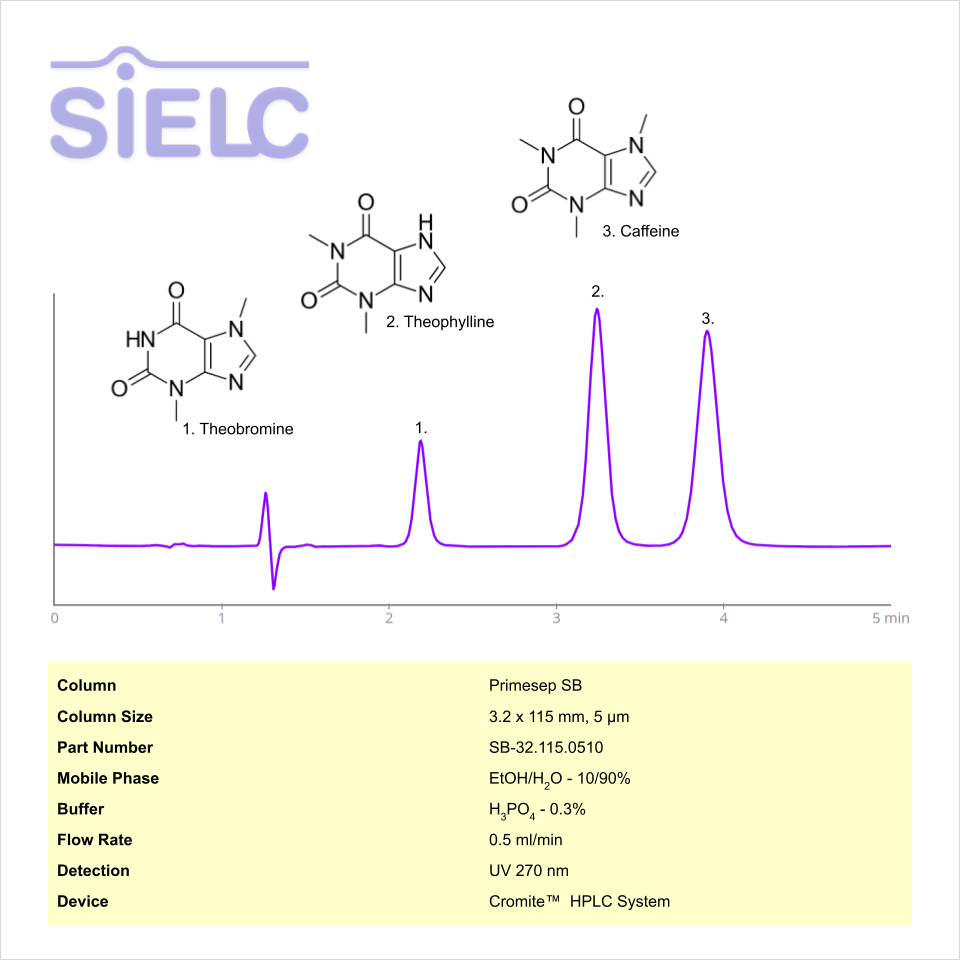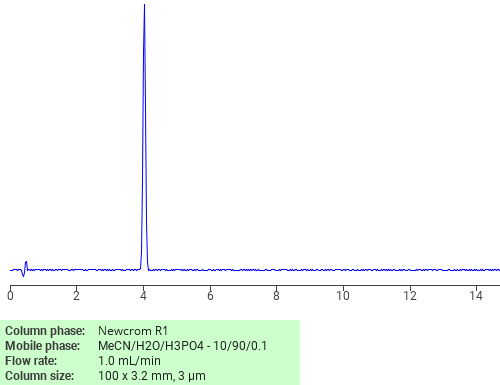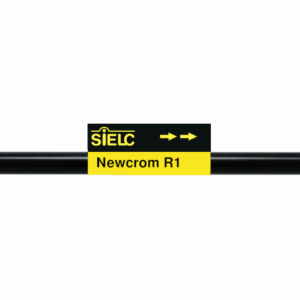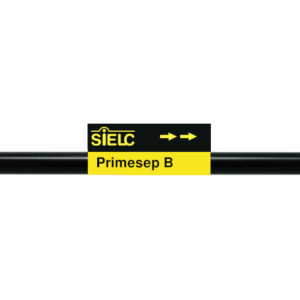| CAS Number | 58-55-9 |
|---|---|
| Molecular Formula | C7H8N4O2 |
| Molecular Weight | 180.168 |
| InChI Key | ZFXYFBGIUFBOJW-UHFFFAOYSA-N |
| LogP | -0.0200 |
| Synonyms |
|
Applications:
HPLC Method for Analysis of Caffeine, Theophylline and Theobromine on Primesep SB Column on Alltesta™
September 23, 2025
HPLC Method for Caffeine, Theophylline, Theobromine on Primesep SB by SIELC Technologies
High Performance Liquid Chromatography (HPLC) Method for Analysis of Caffeine, Theophylline, Theobromine
Caffeine is a natural stimulant and methylxanthine alkaloid. with the molecular formula C6H10N4O2. Caffeine can be found in a variety of plants, including tea, coffea, cocoa, kola nuts, and guarana. Ingestion of it can increase alertness and cognitive function. It can also cause worsening anxiety, heart palpitations, and headaches.
Theophylline is a methylxanthine compound with the molecular formula C7H8N4O2. It is a caffeine metabolite and is often used in forensic analyses. Besides analytical use, it is often used in treating respiratory conditions.
Theobromine is a methylxanthine alkaloid with the molecular formula C7H8N4O2. It is a derivative of caffeine. It can be found in many foods, including chocolate and tea. Despite that, it is toxic to dogs.
You can find detailed UV spectra of Caffeine and information about its various lambda maxima by visiting the following link.
You can find detailed UV spectra of Theophylline and information about its various lambda maxima by visiting the following link.
You can find detailed UV spectra of Theobromine and information about its various lambda maxima by visiting the following link
Caffeine, Theophylline, Theobromine can be retained and analyzed using the Primesep SB stationary phase column. The analysis utilizes an isocratic method with a simple mobile phase consisting of water and ethanol (EtOH) with a phosphoric acid buffer. Detection is performed using UV.
| Column | Primesep SB, 4.6 x 150 mm, 5 µm, 100 A, dual ended |
| Mobile Phase | EtOH- 10% |
| Buffer | Phosphoric Acid |
| Flow Rate | 1.0 ml/min |
| Detection | UV 275 nm |
| Class of Compounds | Alkaloid |
| Analyzing Compounds | Caffeine, Theophylline, Theobromine |
Application Column
Primesep SB
Column Diameter: 4.6 mm
Column Length: 150 mm
Particle Size: 5 µm
Pore Size: 100 A
Column options: dual ended
Theobromine
Theophylline

HPLC Method for Analysis of Caffeine, Theophylline and Theobromine on Primesep SB Column on Cromite™
September 23, 2025
HPLC Method for Caffeine, Theobromine, Theophylline on Primesep SB by SIELC Technologies
High Performance Liquid Chromatography (HPLC) Method for Analysis of Caffeine, Theobromine, Theophylline
Caffeine is a natural stimulant and methylxanthine alkaloid. with the molecular formula C6H10N4O2. Caffeine can be found in a variety of plants, including tea, coffea, cocoa, kola nuts, and guarana. Ingestion of it can increase alertness and cognitive function. It can also cause worsening anxiety, heart palpitations, and headaches.
Theophylline is a methylxanthine compound with the molecular formula C7H8N4O2. It is a caffeine metabolite and is often used in forensic analyses. Besides analytical use, it is often used in treating respiratory conditions.
Theobromine is a methylxanthine alkaloid with the molecular formula C7H8N4O2. It is a derivative of caffeine. It can be found in many foods, including chocolate and tea. Despite that, it is toxic to dogs.
Caffeine, Theobromine, Theophylline can be retained and analyzed using the Primesep SB stationary phase column. The analysis utilizes an isocratic method with a simple mobile phase consisting of water and ethanol (EtOH) with a phosphoric acid buffer. Detection is performed using UV.
| Column | Primesep SB, 3.2 x 100 mm, 5 µm, 100 A, dual ended |
| Mobile Phase | EtOH- 10% |
| Buffer | Phosphoric Acid |
| Flow Rate | 0.5 ml/min |
| Detection | UV 275 nm |
| Class of Compounds | Alkaloid |
| Analyzing Compounds | Caffeine, Theobromine, Theophylline |
Application Column
Primesep SB
Column Diameter: 3.2 mm
Column Length: 100 mm
Particle Size: 5 µm
Pore Size: 100 A
Column options: dual ended
Theobromine
Theophylline

UV-Vis Spectrum of Theophylline
August 4, 2025
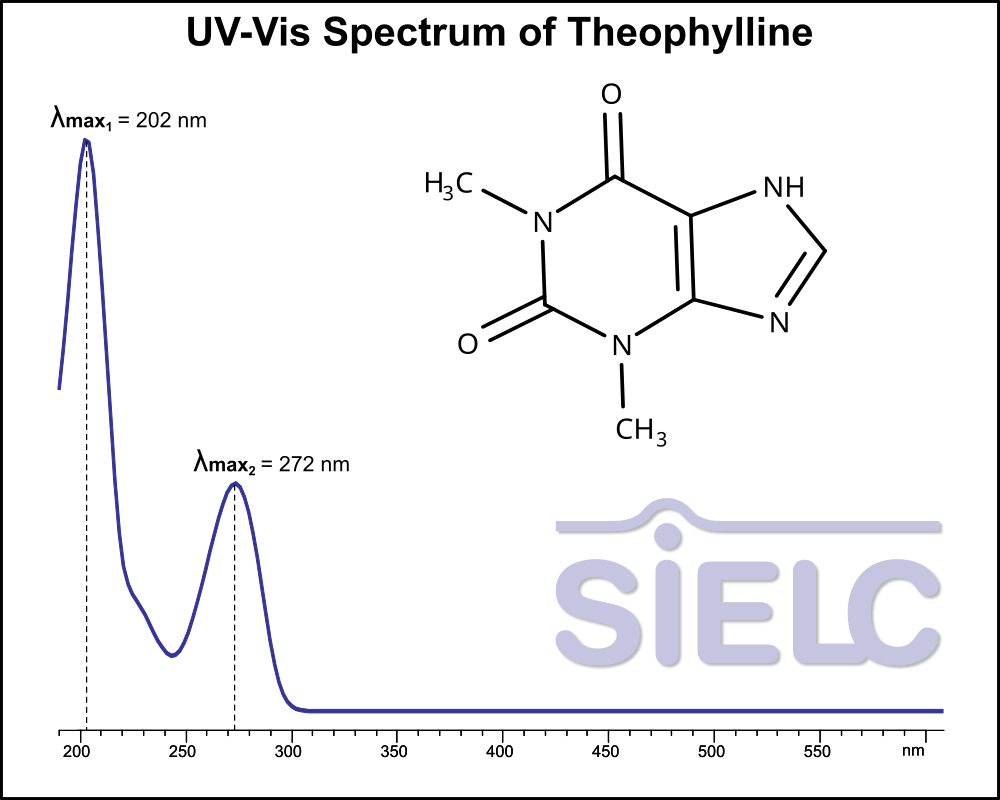
For optimal results in HPLC analysis, it is recommended to measure absorbance at a wavelength that matches the absorption maximum of the compound(s) being analyzed. The UV spectrum shown can assist in selecting an appropriate wavelength for your analysis. Please note that certain mobile phases and buffers may block wavelengths below 230 nm, rendering absorbance measurement at these wavelengths ineffective. If detection below 230 nm is required, it is recommended to use acetonitrile and water as low UV-transparent mobile phases, with phosphoric acid and its salts, sulfuric acid, and TFA as buffers.
For some compounds, the UV-Vis Spectrum is affected by the pH of the mobile phase. The spectra presented here are measured with an acidic mobile phase that has a pH of 3 or lower.

HPLC Determination of Caffeine, Theophylline and Theobromine in Tea on Primesep SB Column
December 17, 2020
HPLC Method for Theophylline, Theobromine, Caffeine on Primesep SB by SIELC Technologies
 High Performance Liquid Chromatography (HPLC) Method for Analysis of Theophylline, Theobromine, Caffeine.
Caffeine is a natural stimulant and methylxanthine alkaloid. with the molecular formula C6H10N4O2. Caffeine can be found in a variety of plants, including tea, coffea, cocoa, kola nuts, and guarana. Ingestion of it can increase alertness and cognitive function. It can also cause worsening anxiety, heart palpitations, and headaches.
Theophylline is a methylxanthine compound with the molecular formula C7H8N4O2. It is a caffeine metabolite and is often used in forensic analyses. Besides analytical use, it is often used in treating respiratory conditions.
Theobromine is a methylxanthine alkaloid with the molecular formula C7H8N4O2. It is a derivative of caffeine. It can be found in many foods, including chocolate and tea. Despite that, it is toxic to dogs.
Theophylline, Theobromine, Caffeine can be retained and analyzed using the Primesep SB stationary phase column. The analysis utilizes an isocratic method with a simple mobile phase consisting of water and ethanol (EtOH) with a phosphoric acid buffer. Detection is performed using UV.
You can find detailed UV spectra of caffeine and information about its various lambda maxima by visiting the following link.
You can find detailed UV spectra of Theophylline and information about its various lambda maxima by visiting the following link.
You can find detailed UV spectra of caffeine and information about its various lambda maxima by visiting the following link.
High Performance Liquid Chromatography (HPLC) Method for Analysis of Theophylline, Theobromine, Caffeine.
Caffeine is a natural stimulant and methylxanthine alkaloid. with the molecular formula C6H10N4O2. Caffeine can be found in a variety of plants, including tea, coffea, cocoa, kola nuts, and guarana. Ingestion of it can increase alertness and cognitive function. It can also cause worsening anxiety, heart palpitations, and headaches.
Theophylline is a methylxanthine compound with the molecular formula C7H8N4O2. It is a caffeine metabolite and is often used in forensic analyses. Besides analytical use, it is often used in treating respiratory conditions.
Theobromine is a methylxanthine alkaloid with the molecular formula C7H8N4O2. It is a derivative of caffeine. It can be found in many foods, including chocolate and tea. Despite that, it is toxic to dogs.
Theophylline, Theobromine, Caffeine can be retained and analyzed using the Primesep SB stationary phase column. The analysis utilizes an isocratic method with a simple mobile phase consisting of water and ethanol (EtOH) with a phosphoric acid buffer. Detection is performed using UV.
You can find detailed UV spectra of caffeine and information about its various lambda maxima by visiting the following link.
You can find detailed UV spectra of Theophylline and information about its various lambda maxima by visiting the following link.
You can find detailed UV spectra of caffeine and information about its various lambda maxima by visiting the following link.
| Column | Primesep SB, 3.2 x 100 mm, 5 µm, 100 A, dual ended |
| Mobile Phase | EtOH – 10% |
| Buffer | H3PO4 – 0.3% |
| Flow Rate | 0.5 ml/min |
| Detection | UV, 270 nm |
| Class of Compounds | Xanthine, Hydrophobic, Ionizable |
| Analyzing Compounds | Theophylline, Theobromine, Caffeine |
Application Column
Primesep SB
Column Diameter: 3.2 mm
Column Length: 100 mm
Particle Size: 5 µm
Pore Size: 100 A
Column options: dual ended
Theobromine
Theophylline

Separation of Theophylline monohydrate on Newcrom R1 HPLC column
May 16, 2018
Theophylline monohydrate can be analyzed by this reverse phase (RP) HPLC method with simple conditions. The mobile phase contains an acetonitrile (MeCN), water, and phosphoric acid. For Mass-Spec (MS) compatible applications the phosphoric acid needs to be replaced with formic acid. Smaller 3 µm particles columns available for fast UPLC applications. This liquid chromatography method is scalable and can be used for isolation impurities in preparative separation. It also suitable for pharmacokinetics.
Application Column
Newcrom R1
The Newcrom columns are a family of reverse-phase-based columns. Newcrom A, AH, B, and BH are all mixed-mode columns with either positive or negative ion-pairing groups attached to either short (25 Å) or long (100 Å) ligand chains. Newcrom R1 is a special reverse-phase column with low silanol activity.
Select optionsTheophylline monohydrate
Effect of Acid on Separation of Xanthines
July 6, 2003
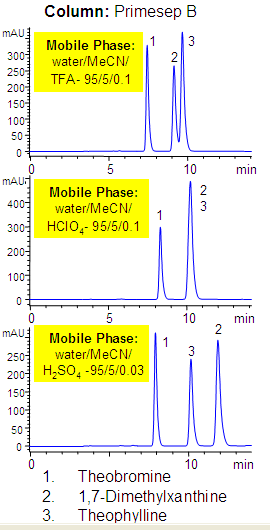
Primesep B separates xanthines such as theobromine, dimethylxanthine, theophylline by a combination of reversed-phase and ion-exchange mechanisms. The anion-exchange properties of the column allow retention of hydrophilic xanthines, and the reversed-phase properties retain hydrophobic compounds. The HPLC separation uses a mobile phase of water, acetonitrile (MeCN, ACN) and either trifluoroacetic acid (TFA), perchloric acid (HClO4), or sulfuric acid (H2SO4) and UV detection.
| Column | Primesep B |
| Mobile Phase | MeCN/H2O |
| Buffer | TFA , HClO4, H2SO4 |
| Flow Rate | 1.0 ml/min |
| Detection |
| Class of Compounds |
Drug, Acid, Hydrophilic, Ionizable, Hormone |
| Analyzing Compounds | Theobromine, 1,7 – Dimethylxanthine, Theophyline |
Application Column
Primesep B
The Primesep family of mixed-mode columns offers a wide variety of stationary phases, boasting unprecedented selectivity in the separation of a broad array of chemical compounds across multiple applications. Corresponding Primesep guard columns, available with all stationary phases, do not require holders. SIELC provides a method development service available to all customers. Inquire about our specially-tailored custom LC-phases for specific separations.
Select optionsTheobromine
Theophylline
Theophylline monohydrate

